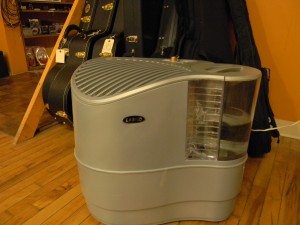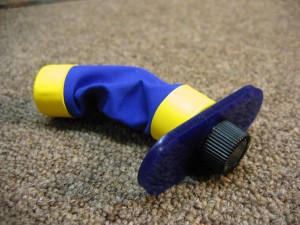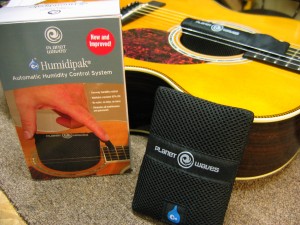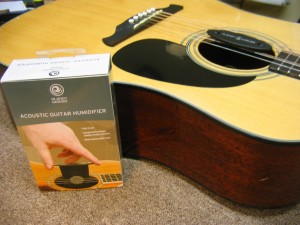“An ounce of prevention beats a pound of cure.” In this post, we’ll break down the best way to protect your guitar in the cool months ahead.

Chicago winters kill guitars. The weather gets dry and cold, so we turn on our furnaces – drying out the air in our homes even further. Many will see their indoor relative humidity drop below 20% . That’s 25-30% lower than the factories where guitars are made and the wood just doesn’t like it. Like the skin on our fingertips and the seams on our hardwood floors, dry guitars can split open without ever being dropped or otherwise mishandled. Other symptoms we see include:
- rough fret ends that stick out past the edge of a fretboard
- loose bridges and braces
- loose neck joints
- separations along the many glue joints that hold a guitar together
- dramatic changes in playing ‘action’
So what can you do to prevent costly repairs to these problems? There’s so many choices hanging in guitar stores that it can be hard to tell which one to buy. Here’s a look at the products that will best help you keep your guitar healthy and happy this winter. You’ll also find a simple formula for how to effectively use them.
We’ve heard some interesting home remedies over the 15 or so years we’ve been working on guitars – from leaving a baggie with a wet sponge in a guitar case to putting an apple or potato inside a case (NOT recommended by this shop!) And we’ve seen lots of products too -from film canister size humidifiers with clay inside to rubber tubes with a sponge inside to space-age devices that can offer protection for months. We’re always looking for answers to this problem and as of 2012, this is our prescription for keeping your guitar properly humidified:
1. Use a good sized room humidifier

We’ are of the opinion that case humidifiers are not enough for many guitars. Create an environment that is healthier for you and your guitar by humidifying your home or at least the room where your guitars live. We’ve grown fond of the Lasko humidifiers like the one above because they hold lots of water – enough for a couple of days at least. 40-50% is ideal, but if you can keep the room’s relative humidity over 30%, you will sleep and breathe better, and your guitar-case humidifiers will be able to do the rest. So how do I know if it’s over 30% then, you ask. A digital hygrometer placed near the case will tell you.

2. Use a guitar case humidifier. Below are our favorites.
First Choice for Acoustic Guitars – Oasis

($20) We really like these humidifiers. They hold enough distilled water to last from one to two weeks without needing to be refilled. Special crystals inside expand into a super absorbent paste that should be replaced each year (replacement kits are available at CFW for $6.) One advantage Oasis holds over every other product is that it will tell you when it’s time to refill by collapsing into a raisin-like appearance that says “Yo! Gettin’ a little dry over here!”

Runner-up Choice for Guitars: Planet Waves Humidipak*

($30) When used with a room humidifier, the Humidipak is a great product that will keep a constant level of humidity inside your case. Three removable packets hang in black mesh pockets (two for the soundhole and one for behind the headstock,) releasing just enough moisture to keep the inside of your guitar case at a comfortable 48% for up to 3 months. Because there is moisture is all in those packets, there’s no need for constant refilling with water. We do have a couple of concerns about the Humidipak, however. First, it cannot do all of the “heavy lifting” when it comes to humidifying the guitar. If the room it lives in is a dry one, it’s going to work much harder and those packets will dry up within a month. Second, while there’s no refilling a water reservoir every week, the packets need to be replaced when they dry out and the cost is about $20 for three. We strongly recommend that it be used in conjunction with a regularly maintained furnace or room humidifier. Read more about it at www.planetwaves.com . While you’re there, be sure to check out the video of Bob Taylor from Taylor Guitars to see what he thinks.
For the tight budget – Planet Waves Humidifier

($8) If you play your guitar every day or two and don’t mind refilling a sponge that often, Planet Waves’ original guitar humidifier is the least expensive option. It’ll work as well as the others but will need more attention.
Humidifying F-hole guitars – Humitron/Dampit tube

($8) Finally, we do keep a few of the old-style tube humidifiers for guitars and mandolins that have F-holes or for those who just like this style. Fill them up every one to two days.
The Recipe For Keeping A Guitar Properly Humidified:
- A FULL humidifer
- Inside the guitar
- Inside the case (NOT hanging on the wall or on a stand.)
- From October through April (or as long as the heat is on in your home)
…Or ignore this advice and come see us in the spring for the best structural repairs anywhere!

Hi,
I just ordered clay jar humidifers (2) that fit inside the case but you’re saying I also need to make sure I have one inside the sound hole as well.
I started using the sponge soaked humidifer I had from last year and then realized just a couple of weeks ago that I think the sponge is not holding water nor is the humidity in the house high enough; began in November; is my Taylor 512 o.k?
I had 300. worth of work done on it about 5 years ago not knowing I ever needed a humidifer at all so now I’m worried; I’m hoping it’s o.k. and that I’m treating it properly. Is the clay o.k. or should I send them back?
Laura, I honestly can’t speak to the effectiveness of the clay jars. I know they hold quite a bit of water which is good but I don’t know how long they can go between refills. I don’t think they could hurt it. The ones listed here are the ones we know best and have the most experience with. Having one inside the soundhole isn’t critical as long as the guitar is in a humidified environment (like the case or a well humidified room.)
As far as whether your guitar is currently okay, you can always bring one in for us to check out – no charge for that. But here are some signs of dryness you can check for: 1) The guitar’s top is sunken into the box of the guitar (concave) rather than having a gentle outward (convex) domed shape. Hold the guitar at eye level and look across the top between the bridge and soundhole for this. 2) sharp fret ends 3) bridge or neck separating from the body 4) unusually high or low playing action. Here is Taylor Guitar’s PDF on symptoms of a dry guitar. Very useful information.